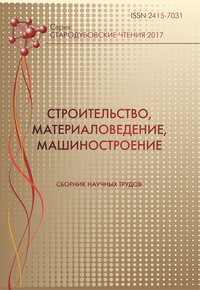The model of the superdeep penetration of microparticles into a metal target at supersonic speeds
Keywords:
Super–deep penetrating, structure, viscidity, the fine structure, a dept penetraing, time of relaxationAbstract
Annotation. Purpose. Creation of the mechanism and model the dependencies between the sizes of microparticles of a micron size, and depth of the ultradeep penetration into a steel target at its bombardment with micro–particles with velocities 1–3 km/s. Methodology. As materials for the study were selected: tool steel R6M5. Studied the structure, fine structure and elemental composition of the targets before and after bombing. A joint analysis of the thermodynamic, hydrodynamic and quantum mechanical calculations with the aim of establishing models of superdeep Printania microparticles. Findings. The complex of theoretical and experimental studies have shown that in the bombardment of metal msenv microparticles with sizes up to 100 µm occurs microsecond a sharp decrease in the viscosity of the metal based on the phenomena of quantum mechanics. Scientific novelty. It is established that during the bombardment of the metal microparticles, which fly at supersonic speed occurs microsecond viscosity loss in metal target for a certain interval of sizes of microparticles. Practical value. Understanding of the mechanisms of ultradeep penetration of microparticles will create for the industry new structural materials with unique properties.References
Usherenko S.M. Sverchglubokoe pronikanie mikrocastits v pregrady i sozdanie kompozitsionnych materialov/ S.М. Usherenko // – Мinsk: NII impulsnych processov s оpynym proizvodstvom. 1998. – 210 p.
Glasmacher U.A. Phase Transitions in Solids Stimulated by Simultaneous Exposure to High Pressure and Relativistic Heavy Ions / Glasmacher U.A., Lang M., Keppler H. et al. // Physical Review Letters, 96, 195701 (17 May 2006).
Sobolev, V.V., Usherenko, S.M. Shock–wave initiation of nuclear transmutation of chemical elements / V.V. Sobolev, S.M. Usherenko // Journal de Physique. IV. – 2006. – 134.–Р.977–982.
Lykov A.V. Teoriia teploprovodnosti / А.V. Lykov // Izd–vo “Vyshaia shkola”.–1967.–599 p.
Sobolev V.V. Mechanism of thick metal walls penetration by high–speed microparticles/ V.V.Sobolev, O.S.Baskevych, L.M.Shyman, S.M.Usherenko // Naukovyi vistnyk NGU, № 6.–2016.–C.75–83.
Plattsman F. Volny I vzaimodeistviia v plazme tverdogo tela / F. Plattsman, P. Volf // Izdatelstvo «МIR», 1975.–436 с.
Bereza О.Yu. Rozrachunok energii chimichnogo zviazky faz, shcho mistiat bor u splavach systemy Fe–B–C / О.Yu Bereza, N.Yu. Filonenko, О.S. Baskevych // Naukovi visti natsionalnogo technichnogo universytetu Ukrainy «Kyivskyi politechnichnyi іnsytut».–№4(84).–2012.–С.116–120.
Chainovet А. Plazma tverdogo tela / А. Chainovet, S. Buchenbaum / UFN.– Т.90, vyp.1.–1966.– 179–193 с.
Fortov V.E. Pylevaia plazma / V.Е Fortov., А.G. Chrapak, S.А. Chrapak [tа іn] // UFN.–Т.174,№5. 2004.– P. 495–544.
Blombergen N. Relaxation Effect in Nuclear Magnetic Resonance Absorbtion / N. Blombergen, E.M Purcell., R.V Pound. // Phys.Rew.–V.73,issue 7.–1948.–679–712 p.
Loitsianskii L.G. Меchanika zhidkosti i gaza/ Loitsianskii L.G. // Uchebn. Dlia vuzov.–М.:Drofa, 2003.–840 p.
Downloads
Published
Issue
Section
License
Редакція Видання категорично засуджує прояви плагіату в статтях та вживає всіх можливих заходів для його недопущення. Плагіат розглядається як форма порушення авторських прав і наукової етики.
При виявлені у статті більш ніж 25% запозиченого тексту без відповідних посилань та використання лапок, стаття кваліфікується як така, що містить плагіат. У цьому випадку стаття більше не розглядається редакцією, а автор отримує перше попередження.
Автори, в статтях яких повторно виявлено плагіат, не зможуть публікуватися в усіх журналах Видавництва ДВНЗ «Придніпровська державна академія будівництва та архітектури».
Автори, які публікуються у цьому журналі, погоджуються з наступними умовами:
- Автори залишають за собою право на авторство своєї роботи та передають журналу право першої публікації цієї роботи на умовах ліцензії Creative Commons Attribution License, котра дозволяє іншим особам вільно розповсюджувати опубліковану роботу з обов'язковим посиланням на авторів оригінальної роботи та першу публікацію роботи у цьому журналі.
- Автори мають право укладати самостійні додаткові угоди щодо неексклюзивного розповсюдження роботи у тому вигляді, в якому вона була опублікована цим журналом (наприклад, розміщувати роботу в електронному сховищі установи або публікувати у складі монографії), за умови збереження посилання на першу публікацію роботи у цьому журналі.
- Політика журналу дозволяє і заохочує розміщення авторами в мережі Інтернет (наприклад, у сховищах установ або на особистих веб-сайтах) рукопису роботи, як до подання цього рукопису до редакції, так і під час його редакційного опрацювання, оскільки це сприяє виникненню продуктивної наукової дискусії та позитивно позначається на оперативності та динаміці цитування опублікованої роботи (див. The Effect of Open Access).

